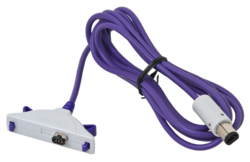 | |
| Also known as | DOL-011 |
|---|---|
| Manufacturer | Nintendo |
| Type | Gamepad adapter cable |
| Generation | Sixth generation |
| Release date | |
| Connectivity | GameCube controller port, Game Boy Advance |
The GameCube Game Boy Advance cable [3] [4] is a video game accessory manufactured by Nintendo which is used to connect the Game Boy Advance (GBA) handheld console to the GameCube (GCN) home console. Depending on the games it is used with, the cable may facilitate transferring data between related games, unlocking additional content, or turning the GBA into a controller or second screen. The accessory is compatible with over 60 GameCube games.